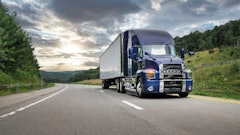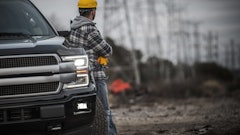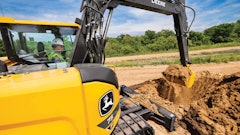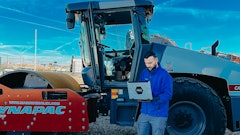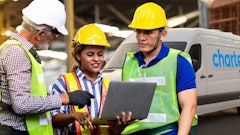
The Equipment Today team asked Ilmars Nartish, vice president - North America, Manitou Group, his thoughts about the industry as we move into 2024. This Q&A features his full comments, including the biggest challenges in 2023 and what we may expect in 2024.
What was the construction industry’s biggest challenge in 2023?
We still had significant supply chain and labor availability challenges [because of] COVID-19 in 2023. And I would say the Great Resignation—which has impacted everyone—has left its marks on the industry and its performance.
The shift that we do see from the equipment standpoint is [that] production capacities have been continuing to grow. Ultimately, that has impacted both the manufacturers and the dealers. I think the industry has been impacted by the flood of equipment on the market, especially for the latter part of the year, as well as the absorption rates of the industry. Where we stand today, maybe we are at a slower pace, although demand is high.
It’s ... like coming in after a drought. Suddenly, you have the flood, and you can't absorb everything that the soil needs. That’s how I would put it into perspective. I feel like the industry is strong. We see certain sectors of the industry maybe softening, maybe weakening. Primarily residential. The housing market certainly is under pressure. On the flip side, we still lack housing inventory. So that's why I feel that, overall, we will see a bounce back in the years to come in the housing market.
Large industrial projects like road construction or infrastructure projects continue at a strong pace. We do see a shift from a demand in the compact equipment market … to larger material handling equipment.
Are changes in the workforce, including retirements, affecting your company?
We see it everywhere, from the manufacturing plants to the office and down to our dealers. All of us are still affected not only by the Great Resignation but also in the fact that today we still have a shortage of skilled labor in the trades. Overall, I think that we need to come forward and show the next generation the great value provided by a career in the skilled trades and give them the road map to achieve it.
What does it mean to become part of this great industry? Why should [they] join? Give that explanation and give that view into the reality of the industry. Because I think that people are still a bit afraid that it’s a “dirty” industry. That is, you need to have a wrench in your hands and have your hands dirty all the time, but that's not the case. We see it in our production facilities. We are still missing technical competencies. It points to the fact that we need to probably join forces as a community to figure out how to attract young talent and the next generation to our industry.
Is your company still experiencing fallout from the pandemic, including supply chain issues or other problems?
The major issue that we still face as a fallout of the pandemic, is primarily linked to the workforce. The unemployment rates in certain parts of the country are at the bare minimum. You can't really attract the workforce if there is not a workforce there to attract. While we see the supply chain improving, ultimately labor remains our major issue.
In what technological areas do you see the potential for the most innovation in 2024?
The one that creates the biggest area of opportunity is data. I think with data, with connectivity, with telematics, we'll see much more use of that, not only from the manufacturer and dealer standpoint but down through to the contractor ... Ultimately when it comes to large capital expenses, everyone is driven by how to lower, justify or mitigate the total cost of ownership. And I do believe that will be heavily supported by data, by access to the data, and linking the data between the manufacturers and dealers. I think that is definitely an area in which we'll continue to see a further expansion, not just in 2024 but … beyond.
I also believe that everyone is focused on safety. And if we talk about safety, we are primarily talking about training—how do we evolve with regard to the training and accessibility to training? And here, when we talk about the different innovative tools, how do we access the tools? How do we access the training on the jobsites? How can we provide that training to the very individual who will be using our equipment? In other words, how do we support that training and awareness through data and technology?
To the point of safety, something which we have been heavily involved in and continue working on, we have worked to provide a visualization of what type of equipment may be necessary on the jobsite so that jobs can be planned and executed better and with a greater eye to safety.
We have been able to provide the data files to the architects, so then they can plan for and anticipate what type of equipment would be necessary to use on a building construction site. I believe that we will see more … expansion and more continuity about how to use, how to generate, how to support and how to even monetize to a certain extent, the data and the service to the customers.
What innovations or improvements do you anticipate in construction equipment in 2024?
Something I can touch on here is … a product line that we have a particular strength here in the North American market: the rotating telehandler … In metropolitan areas in the US, we see the growth in demand primarily in rotating telehandlers. There is a significant growth in that type of construction equipment, which will help construction companies become more effective because [they] can use rotating telehandlers … as a crane … as forklift and as a working platform.
It really serves a big theme in equipment acquisition and fleet management: consolidating the total volume of machines into fewer machines that can serve … multiple roles on a jobsite. In the case of the rotating telehandler, you have three types of equipment in one. We see strong demand going forward and continued, widespread acceptance of rotating telehandlers.
We still need to educate; we still need to present the benefits and explore more of that with the industry. We see a significant growth path and a greater amount of acceptance and deployment in the North American market.
Which construction sectors face the most hurdles in the move toward electrification? Alternative fuels? Automation?
We made great strides in the areas of electrification and alternative fluids in 2023. We introduced a broader range of electric solutions among common material handling equipment categories, such as mobile elevating work platforms and telehandlers, as well as the rotating telehandlers I mentioned earlier. We’ve also been at the forefront of alternative fuel technologies and continue to work on hydrogen cell technology that we first showcased at the end of 2022 in a prototype telehandler.
When we talk about equipment that is driven by electricity, the major issue we face is the duration and capacity of the power [and] the access to electrical infrastructure on new construction builds or remote workplaces. So, you can technically run the equipment for, give or take, about one working day, but what's next? How do you charge? How do you address the need for the power? Those are major considerations that sometimes get glossed over in the electrification conversation. As such, we are one of the few manufacturers addressing the subject by offering range extenders with our electrified machines. These range extenders include a small generator that allows the equipment to recharge itself during use.
The availability of suitable energy infrastructure for powering equipment is even more critical when we talk about other forms of alternative energy. Even if we talk about hydrogen, if we talk about some other fuel types, you come to the point that you need an infrastructure to support and operate. You cannot run the equipment without having a hydrogen tank or someone to pump that hydrogen into your equipment. I think the infrastructure piece is an issue—and is with electric charging stations and other alternative fuel infrastructure.
That being said, I think manufacturers, including Manitou, will continue to address the subject by developing range extenders or other forms of equipment with which you can charge or recharge … at a much faster rate.
The idea of robotics and automation is exciting on a number of levels, but we also live and operate in a multi-purpose, multi-tasking world. We’ve done some great, really jobsite-changing things with remote control technology in our rotating telehandlers. That’s where these technologies can really shine, either taking the operator out of the cab and putting them closer to the work or taking them out of the cab for safety purposes, depending on the work. True robotic automation may have limited widespread use because so much of the equipment used in the industry … is purchased to perform multiple tasks on a jobsite, not just one or two repetitive or repeatable tasks. I think it will come to the construction industry primarily for simple tasks. But overall, I think we will continue to see the demand for human operators, and continued fleet management practices that rely on fewer, multi-capable machines versus automated, robotic equipment.
How are the IoT, software and connectivity affecting your company specifically and the industry as a whole?
Without any doubt, Internet of Things (IoT) and data are embedded in our equipment development roadmap, as well as the overall development of the organization. How do we design the machine? How do we have the entire range of equipment talking in the same language?
That is the starting point for every next step and innovation at Manitou. Of course, when it comes to the upkeep or maintenance of the machine and the relationship between the dealer and the equipment owner, that's where the data will be a significant part of our activity. Data is heavily embedded in our company's roadmap overall. And as for the industry today—data is already a powerful tool that will help companies drive their cost of operation down.
Do you expect the infrastructure bill to affect your business or your customers’ businesses? How, if you can explain further?
When it comes to infrastructure and added investment, every jobsite needs material handling equipment. Every jobsite needs personal lifting equipment. So being the leader in the world of material handling, then definitely we'll see a positive demand for our equipment. The impact of the bill itself is more of a long-term positive source of continuous demand versus a major uptick in demand at any one single moment — so it’s an excellent, foundational source of work that is good for the industry.
What will be the biggest challenge in 2024 for the industry?
Interest rates are at an all-time high, having a significant impact as the cost of funds goes through the roof. It is a significant impact on the industry because anything you build today is going to cost a lot more than it did a year ago. Certainly, I understand everybody has in their mind to ease the inflation, but ultimately the high interest rates will continue to drive costs upward for all of the companies … operating in this space.
When it comes to the big opportunities going forward: it’s the strength of the economy overall. The strength of the economy will be a continuous driver on demand. I don't expect an enormous softening of the construction industry overall. Certainly, some areas will [soften], like residential, but overall, there will be a positive trend upward in the construction industry.
Are there any other insights looking toward 2024 that you’d like to share?
We will be completing our two new factories in Yankton and Madison, South Dakota, where we are sizing and shaping our organization, team and structures … to become an even more significant player in the material handling equipment market in the U.S. and Canada. With both the Manitou and Gehl brands, the North American market is where we are focusing so much growth and where so much innovation that drives real change on jobsites is happening. That includes innovation in both traditional diesel-powered equipment and alternative energies.
We remain committed to focusing on what’s next for the industry. We are already coming to market with an electrical rotating telehandler. We have electrical compact telehandlers and electrical aerial platforms. We're further expanding our product offering in that space, which means that we have emissions reduction in our mindset. We’re already on a strong path with hydrogen technology, all with the goal of expanding our presence and building strong relationships with our customers in the U.S.







